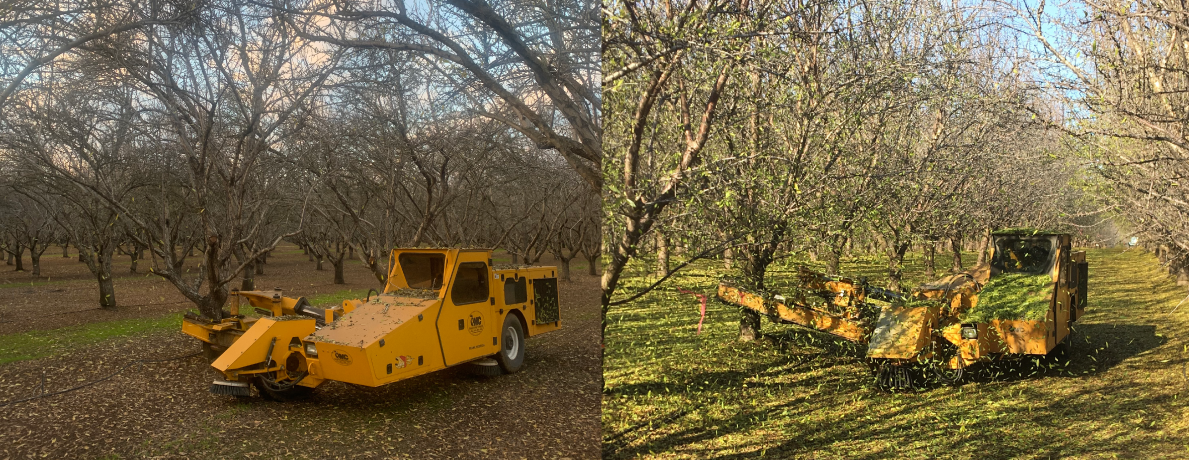As harvest winds down, it’s time to focus on the postharvest to-do list. This includes everything from irrigation to nutrient applications to taking nut samples.
Get Water to Harvested Trees
UCCE Farm Advisor Franz Niederholzer, in Sutter, Yuba and Colusa counties, stressed, first and foremost, irrigation.
“Simply get your water back on as quickly as you can without damaging any nuts that are on the ground,” Niederholzer said, adding adequate, not excessive, moisture is needed.
Almond growers are aggressively working their orchards as soon as the nuts hit the ground in the Sacramento Valley at harvest time, and those with double line drip are moving nuts away from the hose—not piling or windrowing—but rather blowing them away from the driplines, Niederholzer said.
Doing this allows them to start applying modest amounts of water to give the trees a drink as soon as possible while letting the nuts continue drying. This way they avoid a long harvest dry down period which is a huge benefit to the trees.
“That really makes a big difference to the health of the orchard,” Niederholzer said.
With a healthy canopy, the trees can continue to make carbohydrates and store starch and sugars to use in the spring.
“All that stuff sets you up for next year,” Niederholzer said.
“The last thing you want to do is walk away from your irrigation in the fall,” he continued, but it’s easy to overlook when the weather is getting cooler and the days are getting shorter.
Niederholzer suggests following ET. “That’s going to drop as September rolls into October. So you don’t want to irrigate them like it’s July, but adequate moisture is critical to setting the trees up for next year,” he said.
Fall Nutrition
Nutrition in the fall is another important postharvest consideration.
“A fall nutrition nutrient spray is a pretty solid idea, as long as tissue analysis suggest it,” Niederholzer said.
“Foliar boron spray should be considered every year,” he continued. “Make a decision to apply a fall boron spray based on tissue analysis results.”
Boron is the one nutrient that doesn’t really benefit from the leaf analysis. To determine boron levels, a hull analysis is recommended at harvest.
“Cruise across the orchard and grab hulls out of the windrow, send them into the lab and those results will help you assess the boron status of your orchard,” Niederholzer said.
Zinc is another nutrient to look at in the fall. Zinc can be applied at many different times of the year, but it can be done in conjunction with a boron application in the fall. Growers using Solubor or similar sodium borate material may need to adjust the pH of the tank mix when spraying both boron and zinc. Check with your PCA/CCA about tank mixing zinc and boron.
With a record almond crop predicted this year, Niederholzer advises growers to look carefully at their summer leaf analysis numbers.
To date, there hasn’t been any research showing benefits from a postharvest nitrogen fertilizer application (September/October timing) in well managed almond orchards in the Sacramento Valley, Niederholzer said. But in a record crop year with healthy trees that performed well and had plenty of nitrogen in-season, growers still might look hard at their summer leaf analysis and decide if a small application of nitrogen is warranted.
“My experience is that a fall nitrogen application to the soil is probably not going to make any difference to next year’s crop,” Niederholzer said.
Research results didn’t show any improvement in crop the next year by adding nitrogen in the fall, Niederholzer said, however, if the summer leaf analysis shows the trees are deficient, definitely make an application. Only a small nitrogen rate is needed if the trees are deficient, perhaps 30 pounds N/acre.
“If you have low levels of summer leaf N, then an orchard could be short on overwintering reserves, and adding a little bit of N is a good idea,” Niederholzer said.
Niederholzer reminded growers there are many other things that impact crop load next spring other than nitrogen application in the fall.
“In most orchards, the money you spend on that boron spray is going to make more difference to your crop load than a nitrogen application you make, as long as you’ve got adequate nitrogen in the orchard.”
Adding potassium is also a consideration, but potassium is expensive, so growers with solid summer leaf K numbers should consult with their PCA/CCA about a K program for 2021 that keeps adequate K in the trees, but doesn’t break the bank.
“This is a year where you want to pick out the critical things, and make sure you get those right. From my standpoint those are the biggies,” Niederholzer said in terms of nutrient applications.
Nut Samples at Harvest
Taking nut samples at harvest is a good idea, Niederholzer said. Take samples—not from the nut cart—but from the orchard floor before the sweeper builds the windrows ahead of pick up.
Kernels damaged by ants or navel orangeworm are often lost in the harvest and hulling/cracking processes, Niederholzer said. There are companies that will do harvest nut samples for a modest fee, he added.
Obtaining harvest samples and taking the time to crack out and identify the sources of damage is well worth the investment. It’s important to know if the damage came from ants, navel orangeworm, peach twig borer, etc.
When reviewing reject sheets, assume there is at least twice as much damage as the sheets show, Niederholzer said.
“If you have 1% damage on your reject sheets, you probably had at least had 2% damage in the field.”
It’s important to know what is damaging the nuts, whether it’s PTB, Oriental Fruit moth, NOW, ants, etc. as this information can assist growers in making decisions for their spray program for the following year, Niederholzer said.
Ants, for instance, can eat almost all of the kernel, so all that’s left is the skin, and that damage is hard to find after field blowers and air legs at the huller.
“Ants are pretty easy to control inexpensively, but they can do a lot of damage, and if you don’t realize it’s happening you don’t know to take corrective action. Without the harvest sample results, you wouldn’t know to make a special effort to control ants at the next harvest and possibly keep losing crop and money,” Niederholzer said.
“If you see some PTB leaking through, there’s different ways of getting after that. Taking this harvest sample will really give you good information on where the damage is coming from,” Niederholzer said.
Winter Sanitation
Winter sanitation is an important postharvest management practice.
“Sanitation is critical. It’s the foundation of your navel orangeworm management program,” Niederholzer said. It could be really important for the 2021 crop if a light return bloom in some regions leads to larger nuts and poorer shell seals, along with a higher risk of NOW damage.
Some growers will try to shake early and send a machine through the Nonpareils while they’re harvesting the pollinizers, Niederholzer said. Other growers will wait for rain or fog, something that will get some moisture on the dried mummies to give them some weight and help them shake off easier during the dormant season.
The problem with waiting to remove the mummies is it can be difficult to get into the orchards after it rains, but some shakers are being converted to track systems, Niederholzer said. The track system replaces the wheels on side mount shakers.
“Some farm management companies up in the Sacramento Valley are putting tracks on their machines just so they can get out there (if the ground gets too wet),” Niederholzer said, which may allow them to shake mummies deeper into the winter on heavy ground.
Past research suggests that mummy shaking once buds have begun to swell (late January or early February in many years) is feasible. While buds might be shaken from the tree at these timings, only about 25% of all the flowers on the tree need to set to make a good crop in most years, Niederholzer said. However, if return bloom is light in 2021 after this record crop, don’t wait too long to start sanitation.
“If you end up shaking off 10-15% of the flowers on a tree, while you don’t like to see it on the ground, it may not be a measurable impact on the crop,” Niederholzer said, and that would allow growers to wait and shake later. See a recent column on late sanitation by Wes Asai at wcngg.com/2020/01/06/does-late-winter-shaking-reduce-yield-potential-in-almonds/.
Scale
Niederholzer recommended one last thing—taking a spur sample to determine the San Jose and soft scale populations in an orchard. Scale doesn’t have to be treated every year, but keeping an eye on it, especially if there is an aggressive NOW spray program, one including pyrethroid insecticides, is something to consider. The spray program could be harming the beneficials that keep scale under control.
“A dormant spur sample is a good idea, every year,” Niederholzer said.

















